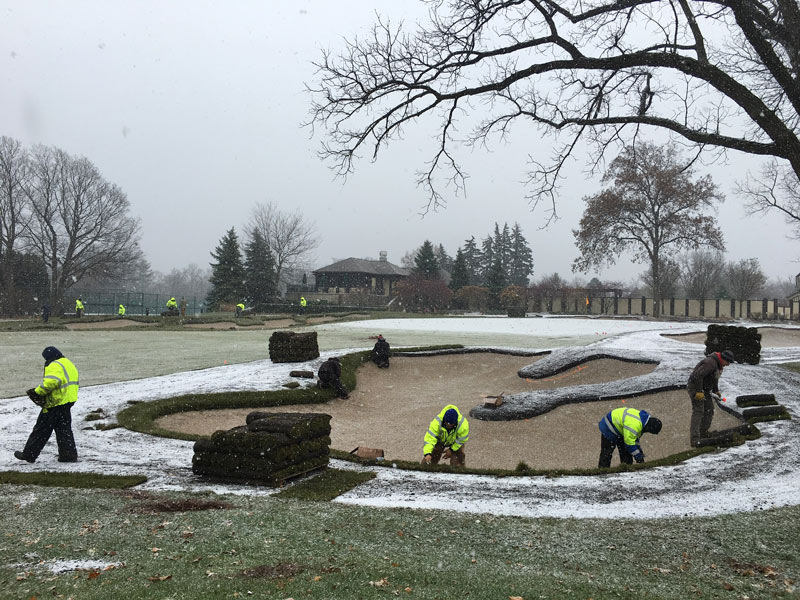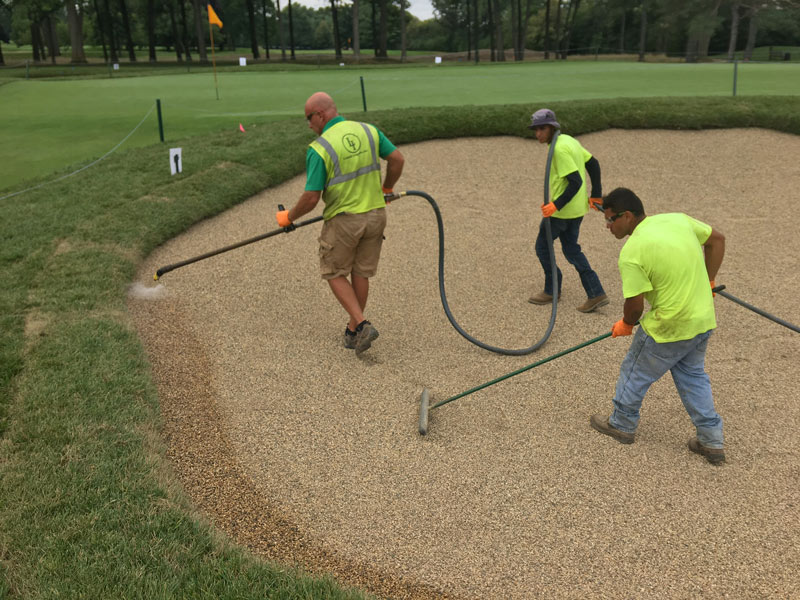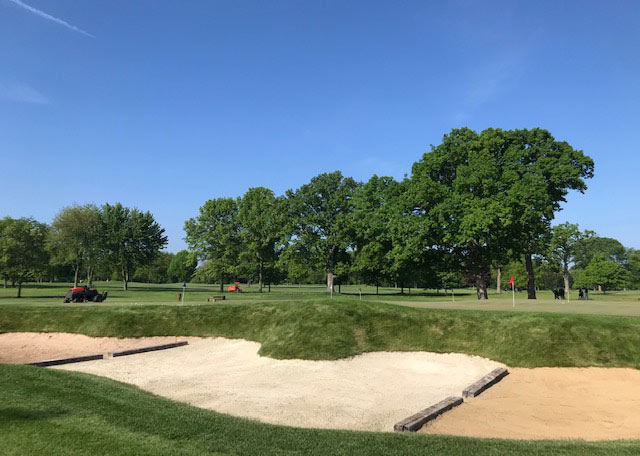
Eventually, every golf course must take on a bunker renovation. With no one “right” way to go about redoing bunkers, a bird’s-eye view of how multiple courses have tackled the task can be a helpful resource. Photo courtesy of Luke Cella
Editor’s note: This article was originally published in the July 2019 issue of On Course, the monthly publication of the Midwest Association of Golf Course Superintendents.
Many of members of the Midwest Association of Golf Course Superintendents have recently redone their bunkers or are in the throes of redoing them now. Knowing there is no right or wrong way to complete this process, we surveyed nine members to find out their processes, material selections, and tips for others in the planning phases of a bunker redo. (Many thanks to those who participated in my quest for information — your willingness to help a fellow member is well appreciated.)
Rich Harvest Farms
Sugar Grove, Ill.
Jeff VerCautren, superintendent
Age of bunkers: It varies. Some are 25 years old and were part of the original construction.
Scope: Ongoing renovation of all bunkers. Fifty-one have been completed out of 101. Most bunkers have new drainage installed (as needed).
Liner: Yes.
Sand: Meyer mason construction sand was used and was chosen because of native color. The course is looking at using Pioneer bunker sand in the future.
Style of bunker: High flashed.
Contractor: Hollembeak Construction for gravel installation and polymer application. Some phases of the project have been done in-house, such as drainage, removal of old sand, and the addition/installation of new sand.
Advice: If installing the Better Billy Bunker system, still add a herringbone drainage pattern — it helps with washouts. After heavy rains, we’ve seen where the sand washed down until it hit the 4-inch tile.
Twin Orchard Country Club
Long Grove, Ill.
Dan Tully, superintendent
Age of bunkers: 16 years.
Scope: All bunkers were redone in 2016. All sand and drainage were replaced in 83 bunkers, which total 61,000 square feet.
Sand: Pro/Angle. It was best-performing sand available.
Liner: None — the bunkers are flat and do not wash out. We did not want a liner to interfere with drainage performance. We used 2-inch micro-slit drain tile and backfilled trenches with bunker sand.
Contractor: XGD and in-house staff.
Advice: Make sure greens really do drain away from bunkers — go look during rain events. It is difficult to keep white sand white, especially on a treed golf course with different sources of tree litter and grass clippings.
Sunset Ridge Country Club
Northfield, Ill.
Greg Rounds, superintendent

Better Billy Bunker being installed at Sunset Ridge Country Club in Northfield, Ill. Photo by Greg Rounds
Age of bunkers: The bunkers were fully redesigned and reconstructed in 2004.
Scope: We started in the fall of 2018 and are wrapping up the complete project — bunkers, irrigation system, a few minor fairway expansions/collection areas, improved drainage in some problem areas — now. In addition to some slight modifications to a few bunker “fingers,” the old sand, liner, and pea gravel was excavated and replaced. The existing drain lines (from 2004) were pulled, cleaned, inspected and replaced back into the existing trenches. One new bunker was added, bringing our total to 96 bunkers/150,000 square feet.
Liner: Yes.
Sand: 100% Pro/Angle.
Architect: Rick Jacobson (our architect) helped us recapture and tweak the 2004 bunker edge.
Contractor: Leibold Irrigation completed both our irrigation install and bunker project.
Advice: The year or two leading up to your project, identify and document precisely (with photos/video) the bunkers that “wash” or have water flowing into them from outside. Have the contractor make the necessary modifications in grading around the bunker and/or add the necessary basins to remediate the problem.
North Shore Country Club
Northbrook, Ill.
Dan Dinelli, CGCS, superintendent
Age of bunkers: 18 years.
Scope: The club decided to reconstruct our bunkers in conjunction with our greens project, both of which were completed in 2017. The old bunkers were 18 years old, severely flashed, with a fabric liner and local sand. Though they had performed well throughout their life span, the sand and fabric started to fail at the same time.
Liner: Yes.
Sand: Pro/Angle Elite Blend (10% brown, 90% white).
Architect: Rick Jacobson.
Contractor: Wadsworth Golf Construction.
Advice: Whatever system or combination of sand/liner/drainage you use, it’s important to let members select what they like from a playability standpoint, but allow them to choose only from systems that work. Don’t give them a choice of something that is unrealistic, unknown or difficult to manage. Realize that once the new system is installed, you’ll have to adjust your practices to manage playability — that’s part of the project.
St. Charles Country Club
St. Charles, Ill.
Chuck Barber, superintendent
Age of bunkers: Very old. Some were from the mid-1980s, and some were from earlier than that, as evidenced by the use of clay drain tile.
Scope: St. Charles chose a complete reconstruction from the ground up. All the bunkers were completely rebuilt and have a new architectural style. We began in the spring of 2016 and completed the remaining 12 holes of bunkers in August 2019. We decreased from 110,000 to 60,000 square feet of sand in 52 bunkers (from 59 bunkers).
Liner: None. This was largely a cost-saving measure as well as a practical one. I didn’t want to deal with staples heaving out of the ground each winter, or tears in fabric, or have to jackhammer out concrete/aggregate liners in the future.
Sand: Pioneer. Our membership didn’t want to transition to a different-colored sand over a long-term, multi-year project. The choice was made to use an improved-performance sand with a similar color to the existing bunker sand.
Architect: Michael Benkusky.
Contractor: Leibold Irrigation combined with in-house labor.
Advice: Build bunkers that don’t allow water to shed into them. Put in as much drainage as you can afford. Build bunkers so they’re easy to maintain — easy to mow/spray/rake/edge. Use a plate compactor once sand installation is complete to immediately firm the sand. Hand-rake if at all possible. Choose sand that drains well but remains firm.
Schaumburg Golf Club
Schaumburg, Ill.
Shane Ritchie, superintendent
Age of bunkers: 25 years.
Scope: Redesign of all bunkers as well as addition of new bunkers. All new drainage inside and tied into existing drainage where possible over the course of 2017 to 2019. We’re flashing the faces with more subtle sloping, with player-friendly designs. The bunkers are a part of a course renovation that includes new greens, new turf on fairways, the addition of elevated family tees, a driving range extension and more.
Liner: Yes.
Sand: Pro/Angle. We liked the way it performed at other clubs.
Architect: Todd Quitno.
Contractor: Golf Creations in 2017 and 2018. Wadsworth Golf Construction in 2019.
Advice: Use a liner such as Capillary Concrete or Better Billy Bunker no matter the sand selection or type. Washouts will still exist if surrounding soil grades do not redirect heavy rainwater runoff away from bunkers, so if at all possible, expand your scope to include this part of the rebuild.
Lake Shore Country Club
Glencoe, Ill.
Jeff Frentz, CGCS, superintendent


To gather feedback from members, Jeff Frentz, CGCS, installed a test bunker with three different kinds of available sand and asked for input before Lake Shore Country Club selected its new sand. Photos courtesy of Luke Cella
Age of bunkers: They were last redone in 2003.
Scope: Full reshaping of all 115 bunkers/156,000 square feet. Club will also add some tees, greenside chipping areas and a limited fairway expansion.
Liner: None.
Sand: North Face. Our members selected it; they didn’t want white sand.
Architect: Ron Prichard and Tyler Rae.
Contractor: TDI will complete the work and Ron Hart will shape.
Advice: Have patience during the planning process. We did a test bunker with three sands, and it was helpful.
Stonebridge Country Club
Aurora, Ill.
Dan Sterr, superintendent
Age of bunkers: This project replaced all bunkers that had been done in-house between 2002 and 2008.
Scope: The project started in October 2018 and was finished in early April 2019. It was the complete renovation of all 57 bunkers, eventually reducing their number to 44. All old sand and liners were removed, bunkers were reshaped, and new drainage, new liners and new sand was installed.
Liner: Yes.
Sand: Pro/Angle.
Architect: Dennis Wise.
Contractor: Hollembeak Construction.
Advice: Use a liner. For us, Better Billy Bunker has performed beyond our expectations. There have been very few washouts, and the contamination of the sand is minimal.
White Eagle Golf Club
Naperville, Ill.
Jim Canning, superintendent
Age of bunkers: 35 years, when the course was built.
Scope: Our renovation began in March 2019 and was targeted to finish by Labor Day. We were fortunate to close nine holes at a time (of the 27) to work on the project. We removed half the area of bunkers. The bunker style has completely changed from a “cape and bay” to a more modern look, with very steep banks and clean lines. Bentgrass surrounds the bunkers in the fairways. Greenside bunkers are pushed against the collars.
Liner: Yes.
Sand: Pro/Angle. Members wanted white sand.
Architect: Todd Quitno.
Contractor: Leibold Irrigation is doing both construction and irrigation installations.
Advice: Be patient; be organized.
Bunkers are a big deal, and it’s apparent that clubs and course owners are willing to invest heavily into these “specially prepared areas intended to test the player’s ability to play a ball from the sand” (Rules of Golf, Rule 12).
“Specially prepared” might be an understatement.
Luke Cella, CGCS, is the executive director of the Midwest Association of Golf Course Superintendents, a position he has held for 16 years. He is a 24-year member of GCSAA.